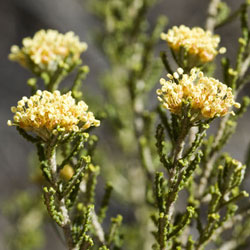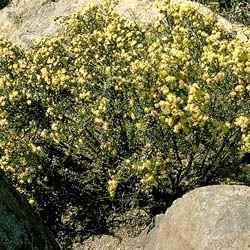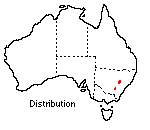Phebalium squamulosum
subsp. parvifolium
 |
 |
Scaly Phebalium
Phebalium squamulosum subsp. parvifolium Paul G.Wilson
Phebalium squamulosum subsp. parvifolium is a small shrub belonging to the Rutaceae family and is one of ten subspecies all of which occur in eastern Australia. It is not common in cultivation but has many attributes which make it useful as a garden subject.
At maturity it is a compact rounded shrub up to 1 m high and 1 m wide with some tendency to twiggy growth. The leaves are small and narrow, 5-8 mm long and 1 mm wide, with glossy, dark green upper surfaces and smooth, pale lower surfaces.
At the Australian National Botanic Gardens in Canberra the shrub flowers prolifically
in October and early November with clusters of tiny, pale yellow five-petalled
flowers at the ends of the branchlets. The pale yellow stamens protrude beyond
the petals giving the flowers a feathery appearance. Unlike Boronia and Eriostemon, related genera in the Rutaceae family, it has no distinctive
flower or foliage perfume.
The natural occurrence of this plant is on the semi-arid central western slopes
and plains of New South Wales around Ardlethan, West Wyalong and as far north
as Nymagee. The soils are sandy red earths, which are mildly acid at the surface
changing to neutral or slightly alkaline with depth. The plant grows in mallee
communities together with shrubs such as the red-flowering Prostanthera aspalathoides.
Mean annual rainfall for the area ranges from 300 to 500 mm.
In the Botanic Gardens this subspecies has been planted in a variety of situations. Best growth rates have been achieved in the rockery where a three-year-old plant has reached 60 cm in height and is 60 cm wide, growing in a mix of equal proportions of sand and peat and receiving regular watering. However, some leaf yellowing and drop has been observed suggesting that the relatively high applications of moisture and high peat content of the mix may not be conducive to longevity. Elsewhere in the Gardens on unimproved soils and with less regular watering growth rates are somewhat slower but the plants retain a robust appearance.
In a Canberra home garden the plant is reported to have reached 1 m in height and 1 m in width after eight years, growing in a sheltered position with half sun. The soil had a high clay content and little watering.
While being reasonably adaptable in cultivation, P. squamulosum subsp. parvifolium prefers a well-drained soil in a relatively dry site with a slightly acid to neutral pH. These preferences reflect the plant's natural habitat. This subspecies is frost-hardy and a position in full sun or half shade is suitable as the shrub flowers well in either location.
Although it has a neat, compact and rounded shape in its natural environment, pruning at flowering, or soon after, keeps the shrub dense and lessens the tendency to twigginess. The only pest reported is a scale insect that may be controlled manually or by low-toxicity chemical products. Consult local experts for advice if the occurrence is serious.
Propagation is by cuttings taken after flowering in late spring and struck in a sharp-draining cutting mixture. The compact size and habit of this Phebalium, together with its pale yellow spring flowers, make it a very useful plant in any garden. It can be planted in low shrub borders, in front of larger shrubs, as a rockery specimen, or in association with mallee vegetation and other small trees. Its fine textured foliage provides a contrast with other bolder shrubs.
Text by Keith Bailey, ANBG (1986)
Name meaning: Phebalium squamulosum subsp. parvifoliumPhebalium - said to be from the Greek, phibaleos, a kind of fig (from phibalis - the name was thought to refer to a myrtle and so (mis-)applied to this genus); squamulosum - from Latin, meaning covered with small scales; parvifolium - from Latin, parvus, small and folium, leaf. |
![An Australian Government Initiative [logo]](/images/austgovt_brown_90px.gif)

